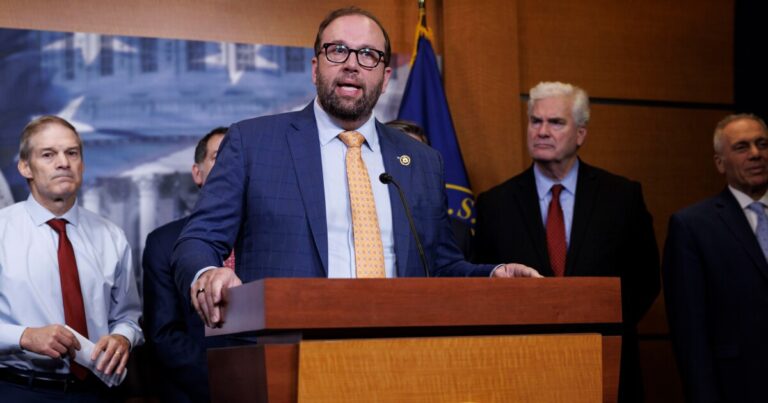Congressional Republicans are betting bigger tax refunds ahead of midterm elections paid for by cuts in social programs afterward will overcome early public disapproval of President Donald Trump’s signature tax law.
Timing is on their side. Voters will collect larger refunds on their tax bills before they head to the polls, but the brunt of the reductions to programs like Medicaid and food assistance for the poor won’t materialize until after the ballots are counted.
“Next year they’re not gonna have people kicked off Medicaid. They’re going to have no tax on tips, no tax on overtime, tax relief for seniors,” said Representative Jason Smith, one of the chief architects of the tax law. “All of that’s going to be there when they file their taxes.”
Fifty-two percent of Americans disapprove of the tax law, according to a late July Wall Street Journal poll. At least half of respondents said the law would harm poor people, the working class, the U.S. economy and the federal budget deficit.
Republican Representative Mike Flood of Nebraska confronted furious criticism of the tax bill at a constituent town hall meeting in his district earlier this week. Most Republican lawmakers have avoided similar large forums this month and dismiss the protests as the work of Democrats and other opponents of the tax law.
Smith and other Republican leaders say they expect sentiment to shift.
The Missouri Republican, who chairs the House Ways and Means Committee, said he “advocated aggressively” to make tax cuts retroactive to the start of this year. The decision means voters will reap the tax benefits of the new law early next year as they file their 2025 taxes.
Taxpayers who qualify will see the benefit of a larger standard deduction, child tax credit, deduction for seniors and cap on state and local tax deductions, along with exemptions for tips and overtime wages, reflected in their tax refunds early next year.
Meanwhile, the more than $1 trillion in cuts to social programs aren’t scheduled to take effect until after the midterm elections next year.
Whether Republicans are successful will in part depend on how early states and health care providers start making cuts in anticipation of a decrease in federal support.
Another wild card is the impending expiration of a Biden-era expansion of Affordable Care Act insurance premium tax credits that has been offsetting health care costs for low- and middle-income households. The tax law didn’t extend the more generous premium credit, causing it to lapse at the end of the year.
Tariffs and their economic effects also will shape voters’ perceptions, with Democrats concentrating their fire on the cost of living.
“Families are feeling the impact of cost hikes already and tariff impacts, as well as just the ongoing uncertainty created by this administration,” said Representative Suzan DelBene. The Washington lawmaker chairs House Democrats’ campaign arm.
Lessons from 2017
Congressional Republicans deliberately shaped the new tax law to try to avoid repeating what they concluded were mistakes in Trump’s first-term tax law, passed late in 2017.
Key Republicans believe voters didn’t fully appreciate tax cuts that took effect in 2018 in time for that year’s November midterm election, which lost the GOP control of the House.
That’s one reason Smith pushed to make many of the tax cuts retroactive this time, enlarging tax refunds that will be paid out early in the coming election year.
“We focused on making sure that Americans got real tax relief immediately,” Smith said.
Economists say the new law could offer a boost to economic growth between now and the midterms, though estimates differ on just how much. Most Americans, however, are likely to see an increase in their take-home pay.
Middle-income earners are estimated to see an average $1,430 boost while the highest earners would see at least a $7,000 increase, according to a Penn Wharton Budget Model analysis. Conversely, the lowest-earning 20% of households — with a household income up to about $18,000 — would on average see a $165 drop in their income next year after taxes and transfer payments are included.
Even so, tariff-related price increases could easily swamp many Americans’ tax savings, said Kent Smetters, faculty director at The Penn Wharton Budget Model.
Consumers’ costs may rise by a couple hundred dollars or a thousand, he said. “It’s going to come really down to how aggressive Trump decides to be.”
Garrett Watson, director of policy analysis at the Tax Foundation, said the impact on personal finances and how that influences people’s perceptions could vary widely because many of the tax breaks are targeted to specific groups.
“It could be very lumpy next year in terms of people’s perceptions of, is the law helping them?” Watson said.
Pay later
Republicans delayed many of the provisions projected to squeeze low and middle-income households, including cuts to Medicaid and the Supplemental Nutrition Assistance Program, largely slated to take effect after the midterm elections.
The new law’s sweeping changes to Medicaid —including work requirements, a higher cost-share for patients, and a cap on health care provider taxes states use to unlock more federal funding — go into effect on a rolling basis starting at the end of 2026 through 2028.
Changes to SNAP — formerly known as food stamps — requiring state governments to pay part of the cost of benefits for their residents don’t take effect until Oct. 1, 2027. Expanded work requirements for beneficiaries could take effect as soon as states are ready to move forward with them.
Even so, Representative Steven Horsford, a Democrat from a competitive Nevada district, said voters will likely feel the effect of health care cuts before the midterms, as states, insurers and health care providers cut back in anticipation of the coming shortfall.
“Health care providers and insurance plans aren’t going to wait until the date of implementation. They’re going to start making those changes,” Horsford said.
Representative Richard E. Neal, the top Democrat on the Ways and Means Committee, said even if cuts to social programs are postponed until after the midterms, his party still has a simple and effective message. Republicans are taking from the poor and working class to give to the rich, he said.
“People understand that,” he added.


